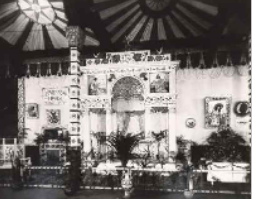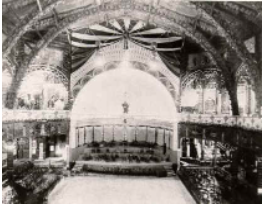1891 Sioux City Corn Palace
The 1891 Palace was so large that it spread across Pierce Street and featured a large archway that allowed traffic to pass through. The palace featured a balcony atop the main 200-foot tower. There, visitors could take in a magnificent view of the city and the surrounding three states.
Once again the spacious interior allowed space for concerts by nationally famous bands.
A popular exhibit was a scene from Romeo and Juliet. They were made of corn silk and husks. They stood on a white corn balcony from which dangled a ladder made of husks and corn.
Local citizens still constructed most of the interior displays, but now there were exhibits from other states and businesses. Some of the railroads serving Sioux City competed with each other in presenting elaborate displays.
Still, the ladies of the Lilac History Club of Sioux City won first prize with their miniature library made completely of corn, small grains, and native grasses. According to the Journal, "The walls were covered with corn pictures and the floor with a grass rug. On a tiny table stood quill pens crafted from cane and oat straw. A corn lamp, gourd inkwell, and cornhusk blotter completed the setting."
The 1891 Festival was the biggest and some say the best. But the weather was the worst. Cold drizzly days kept attendance down in the unheated palace. The festival of 1891 did not live up to its expectations. In fact, the low revenues left the sponsors with a problem. What do you do with a Corn Palace in your business district when you don't have enough money to tear it down? The wooden palace attracted people, but it also attracted birds and rodents. No wreckers wanted to buy the palace, and finally, an auction was organized with the palace going to the highest bidder. So for a bid of $1200, H.H. Buckwalter got a Corn Palace. His son Frank and some of his friends began to take down the carefully constructed corn mosaics and decorations.
They hoped to make money by salvaging as much of the material as possible. They discovered that sheep would eat the corn, carefully avoiding the nails. So they found a market for the corn! They also salvaged lumber, nails, and bunting.
Despite poor attendance at the 1891 festival, promoters made plans for the next palace. But in May of 1892, the Great Floyd River Flood devastated Sioux City. A wall of water six feet high came without warning and did tremendous damage, especially to homes in the South Bottoms area. Ten people died and between 400 and 500 homes and businesses were damaged or destroyed. The devastation was so severe that city officials had to request outside help in rebuilding the flooded area.
With all of these financial losses, officials didn't feel they had enough money to build a palace that year. Plus, many people did not think it was proper to spend money on a festival so soon after asking for financial assistance. Instead, they decided to wait until 1893 to build the next palace. James F. Toy, a prominent businessman, said, "No one wanted to drop the Corn Palace idea for good. All agreed that it is too much of a Sioux City institution and too novel for that. We will get together next year and build a stunning palace."
Unfortunately, the Financial Panic of 1893 ended plans for future corn palaces once and for all.





